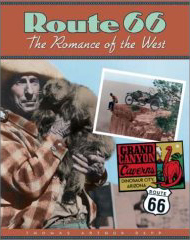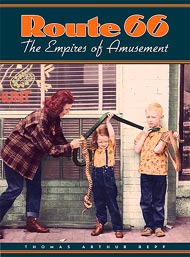Route 66: The Romance of the West, by Thomas Repp
Modern travelers on the old historic roads drive vehicles that don't need those kinds of services more than once every 200 miles or so, and it's our general belief that travelers rarely see things they aren't looking for. This is why books like Route 66: The Romance of the West can provide a wonderful way to see into worlds that, at first appearance, no longer exist. Author Thomas Repp has written two books about the Mother Road. His first, Route 66: The Empires of Amusement, focuses on vintage roadside attractions from Illinois to Texas. His new opus traces the history of attractions in New Mexico, Arizona, and California.
I have never been comfortable with the exploitation of animals and reptiles as profit-making enterprises, but the author does a masterful job of bringing those long-closed establishments to life in the telling of stories about the families who developed and operated these roadside attractions. Probably the most compelling is the story of Atkinson's Cobra Gardens located at the Lost Canyon trading post near Grants, New Mexico. Herman and Phyllis Atkinson cared for an impressive reptilian menagerie that included king cobras, mambas, pythons, and rattlesnakes. By 1953 they had amassed the largest collection of cobras in America. An outstanding photo in the book shows Herman gently cradling an enormous rattlesnake.
One tale I particularly enjoyed is the story of Leo the lion who took liberty one day and wandered into a café at Top of the World, a roadside trading post located at the continental divide. Luckily for the tourists eating in the booths, Leo was frightened by the ensuing commotion, which allowed Tex Hargus to place a lariat around his neck and lead him back to his cage.
Repp has included many colorful anecdotes, but the chapter that "made" this book for me focuses on Potapov's lemonade stand. This memorable roadside stop flourished in a rock-walled gasoline station just east of Oro Grande near Barstow, California. I have driven past this aging relic dozens of times but never known anything of its history. According to the author, most of the rock buildings built in the area were constructed by Guy Wadsworth, who always constructed a "well house" on any property he built. He was a bootlegger of some renown, and the so-called well house was there to hide the booze. Now there's a great example of good old-fashioned entrepreneurship!
In addition to an abundance of well-told
tales, Route 66: The Romance of the West lives up to
its title because of the illustrations the author has woven
in with his narrative. Historic and current photographs, advertising
bills, and other photographic mementos bring his vivid stories
to life. This is a vibrant tapestry of a book that allows
all of us 21st century roadtrippers to enhance our experience
of what's out there today with a better appreciation for the
romance and mystique of the heyday of America's "Mother
Road."
Mark
Sedenquist
1/22/06


